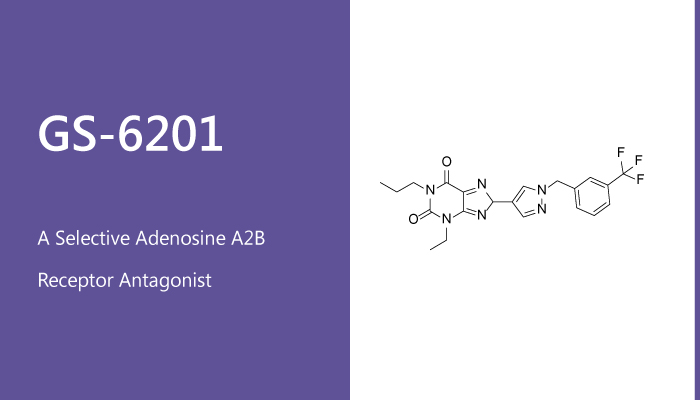Adenosine is an endogenous purine nucleoside present in every cell of the human body. Four distinct adenosine receptor subtypes are A1, A2A, A2B, and A3. They belong to the family of G-protein-coupled receptors. Adenosine interacting with its receptors will initiate signal transduction pathways. Activation of the A1 and A3 adenosine receptors inhibits adenylate cyclase activity through the activation of pertussis-sensitive Gi proteins. Thus, it results in a decrease in intracellular levels of cAMP. On the other hand, activation of the A2A and A2B adenosine receptors stimulates adenylate cyclase via activation of Gs proteins. Then, that leads to the intracellular accumulation of cAMP. Adenosine receptors play an important role in chronic inflammatory airway conditions, such as asthma, chronic obstructive pulmonary disease (COPD), and fibrosis. In this study, GS-6201 is a selective adenosine A2B receptor antagonist and displays high affinity and selectivity for the human adenosine A2B receptors (Ki=22 nM).
GS-6201 is a selective blocker of the A2B adenosine receptor.

GS-6201 is a selective blocker of the A2B adenosine receptor. It reduces caspase-1 activity in the heart and attenuates cardiac remodeling after acute myocardial infarction (AMI) in the mouse. In addition, GS-6201 leads to a significant attenuation of left and right ventricular enlargement and dysfunction at 7 days, which was maintained at 14 days and also at 28 days. Furthermore, GS-62013 attenuates the airway reactivity induced by NECA, AMP, or allergen in sensitized mice. It significantly reduces IL-6, TNF-α, E-selectin, ICAM-1, and VCAM plasma levels.
In summary, selective blockade of A(2B) AdoR with GS-6201 reduces caspase-1 activity in the heart and leads to a more favorable cardiac remodeling after AMI in the mouse. Meanwhile, GS-6201 also plays an important role in the inhibition of airway reactivity and inflammation in this model of allergic asthma.
Reference:
Elzein E, et al. J Med Chem. 2008 Apr 10;51(7):2267-78.
Toldo S, et al. J Pharmacol Exp Ther. 2012 Dec;343(3):587-95.